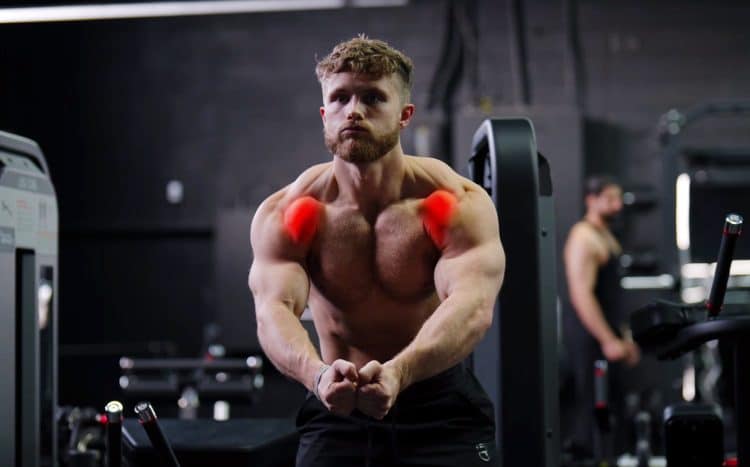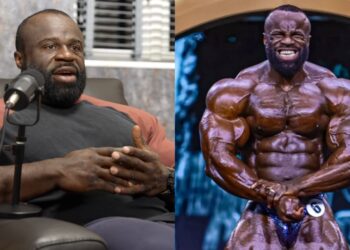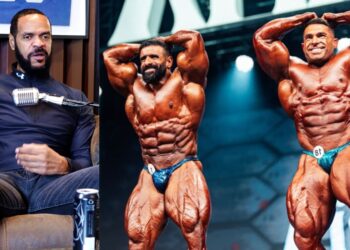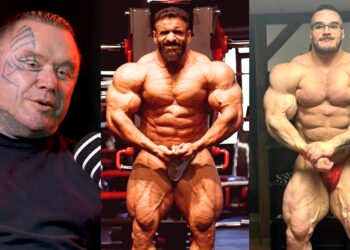Fitness expert Jeff Nippard and exercise scientist Dr. Mike Israetel shared their top picks for shoulder exercises to achieve complete shoulder development. A pair of strong and pronounced shoulders is essential for performing upper body activities and day-to-day tasks. It is also of utmost importance to build solid shoulders from a bodybuilding perspective. Shoulders cap the upper body and their development is essential to create a complete look for aesthetic purposes as well.
Jeff Nippard is a Canadian natural bodybuilder, powerlifter, and fitness expert. He has become a prominent name in the online fitness community for science-based fitness content and a strong inclination towards research. Nippard is the 2012 Junior Mr. Canada and at one point, he held the Canadian national record for bench press. His bodybuilding knowledge comes from years of training, study, and a bachelor’s degree in biochemistry.
Over the years, Jeff Nippard has trained several natural bodybuilders and powerlifters to achieve their goals. His YouTube content revolves around sharing bodybuilding knowledge and directing the audience in the right direction for maximum growth. Recently, he partnered with exercise scientist Mike Israetel to share shoulder-building techniques.
In a world where diet and training-related fads have become a common occurrence, Dr. Mike Israetel stands out as an expert who debunks a lot of myths around popular practices. He holds a Ph.D. in Sports Physiology and urges people to understand the real science behind these methods.
View this post on InstagramGet Fitter, FasterLevel Up Your Fitness: Join our 💪 strong community in Fitness Volt Newsletter. Get daily inspiration, expert-backed workouts, nutrition tips, the latest in strength sports, and the support you need to reach your goals. Subscribe for free!
Jeff Nippard and Mike Israetel share their go-to exercises for shoulders
Nippard revealed a staggering statistic about anterior deltoid exercises and stated that most lifters have five times more anterior deltoid development than non-lifters compared to a relatively less three times more development of lateral deltoids. The reason? Overemphasizing the volume for anterior deltoid muscles, which are activated with most of the compound chest exercises anyway. Nippard backed his claims with a German study from the 1990s and suggested limiting the anterior deltoid volume.
Mike Israetel agreed with Nippard’s findings and added:
“I’ll go overboard and I would say rear delt training is overrated as well. If you’re training your back properly, your rear delts should be very well developed. You can also pour a lot of volume into the side delts.”
He further stated that from a bodybuilding perspective, it is the lateral delts that create the visual effect of having massive shoulders. Therefore Dr. Israetel thinks that lateral delt training should comprise 70 to 90 percent of the total shoulder training routine.
With that, both men shared their top three exercises to target the anterior, posterior, and lateral deltoids and explained the thought process behind them.
Anterior Deltoids
Nippard – Machine Shoulder Press
Jeff Nippard’s go-to exercise for anterior delt development is the seated machine shoulder press. Seated variations eliminate the involvement of core and other stabilizing muscles from the exercise and enable focusing more on the target muscles.
Additionally, most people can push more weight on the machines without worrying about controlling the weight and technique as the weights on machines move along a fixed trajectory.
Personally, Jeff Nippard likes to use the Panatta plate-loaded machine because it allows a full range of motion and a big stretch on the front delts.
“Another thing I like about this machine is that it’s unilateral. Meaning, each shoulder is forced to work individually, which can be great for fixing any left or right shoulder imbalances,” Nippard said.
The Canadian fitness expert usually adheres to a six to ten-rep range for doing this exercise. But if you don’t have access to the machines, even the seated dumbbell shoulder press can induce a similar effect.
Israetel – EZ Bar Front Raises
While most people would employ compound pressing movements for anterior deltoid development, Dr. Mike Israetel has a completely different take on this. EZ bar front raise is his go-to exercise for front delt stimulation. He explains:
“One of the reasons is that it gives a ton of motion to the front delts. So a huge range of motion there. And also because it is an isolation exercise. It’s pretty rare to see. For front delts, most people choose a compound press which is cool. But if your tricep volume is where it is, if your pecs are sore, if your shoulder joints are upset with you because you’ve been doing a lot of pressing, maybe the overhead press is not on the cards.”
To get the maximum effect of the front raise for anterior deltoid development, Dr. Israetel also suggested doing the front raises on a cable machine. This allows you to take the hands behind the plane of your body, enabling a big stretch in the anterior deltoids.
EZ bar front raise is a practical alternative for those who do not have access to machines. The key is to keep the chest up to get the maximum stretch in the anterior deltoids. Raise the bar as high as you can without breaking the posture. The real magic happens when you lower the bar with slow and controlled motion through the eccentric phase.
“I would say the most effective part of the movement, generally, there are some nuances here, it’s from 45 degrees to 135 degrees (The upper half of the range of motion).”
Get Fitter, FasterLevel Up Your Fitness: Join our 💪 strong community in Fitness Volt Newsletter. Get daily inspiration, expert-backed workouts, nutrition tips, the latest in strength sports, and the support you need to reach your goals. Subscribe for free!
Mike Israetel suggests using a higher range of motion and doing this exercise for 10 to 20 reps.
Lateral Deltoids
Israetel – Super Range of Motion (Super-RoM) Lateral Raises
The super range of motion lateral raise is a lateral raise where you lift the weight as high up as possible instead of stopping at shoulder height. The increased range of motion keeps the muscles under tension for a longer duration and helps bring about hypertrophy more effectively. Mike Israetel suggests doing this for 10 to 20 reps.
Nippard – Crossbody Cable Y-Raise
Jeff Nippard puts this lateral delt movement on top of other exercises because of the stretch it gives at the end of the eccentric phase.
“If you were trying to get a stretch in your side delt, you wouldn’t just hold it (in a neutral position along the side of your body). You’re not getting a ton of stretch here. If you pull it across your body, now you have more stretch on the delt.”
Nippard cited anatomy research which shows that there are not three but seven distinct heads in the deltoid regions that fan out in slightly different angles. Therefore, working the muscles from different angles and positions can yield significantly better results by targeting all the muscle heads.
Posterior / Rear Deltoids
Israetel – Super Arm Reverse Cable Flyes
This is Mike Israetel’s go-to exercise for targeting the posterior deltoid muscles. He advises keeping the arms crossed at the beginning of the rep. While it may create an imbalance based on which arm is above and which one is placed lower, you can address the issue by switching them up for alternate reps.
“You want generally to keep your elbows locked out so that you can make sure it’s all rear delts. You will not be able to use as much load that way but minimizing load and maximizing muscle involvement is a really good thing,” Israetel said.
Dr. Israetel added that pulling the cables back until you feel peak contraction of the posterior deltoid muscles is another important aspect of doing super arm reverse cable flyes.
“You can feel the burn accumulating while you do it. And then slowly peel that muscle out on the way back. So it’s a really good thing to really crunch at the top. It won’t cost you a ton of reps because it’s easy there. But you’ll connect to that rear delt.”
Nippard – Reverse Pec Deck Flyes
This is one of the most commonly utilized exercises for rear delt development. While Jeff Nippard ranks this at the top of his list of rear delt movements, Mike Israetel shared an important tip to get the most out of it by reducing the weight and still getting maximum stimulus.
“For good rear delt training, you want to reach forward really far. Also, you’ll notice that it pre-stretches the rear delts. You’re not pulling, you’re arching out to paintbrush as far of a distance as you possibly can. Punch forward and then sweep out!”
Overall, here are Jeff Nippard and Mike Israetel’s best picks for shoulder exercises:
Jeff Nippard
- Anterior Deltoids – Machine Shoulder Press
- Lateral Deltoids – Crossbody Cable Y-Raises
- Posterior Deltoids – Reverse Pec Deck Flyes
Mike Israetel
- Anterior Deltoids – EZ Bar Front Raises
- Lateral Deltoids – Super Range of Motion (Super-RoM) Lateral Raises
- Posterior Deltoids – Super Arm Reverse Cable Flyes
Jeff Nippard and Mike Israetel are known for their cerebral approach to training and sustainable training methods. While one size does not fit all, the exercises recommended by them are certainly worth trying out.
Watch the full video below, courtesy of Jeff Nippard’s personal YouTube channel:
More Shoulder Workouts:
- Calisthenic Shoulder Exercises and Workout
- Best Barbell Shoulder Workout for Bigger, Stronger Delts
- Best Compound Shoulder Exercises and Workouts
- Best Shoulder and Bicep Workout for Strength and Size
- Best Deltoid Workouts and Exercises Using Machines to Sculpt Huge Shoulders
- Bigger Shoulders In Less Than 30 Minutes-Session









